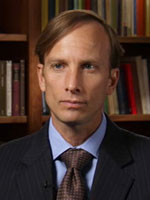Q and A with Ambassador Mark R Dybul, MD
September / October 2012 | Volume 11, Issue 5
In his role as US Global AIDS Coordinator from 2006 to 2008, Ambassador Mark R. Dybul, M.D., helped create and implement the President's Emergency Plan for AIDS Relief (PEPFAR), the largest international health initiative launched for a single disease. Today, PEPFAR's mandate expands beyond HIV/AIDS. It supports the Medical Education Partnership Initiative (MEPI). (See the related article Africa transforms its medical education with MEPI.) Dybul is now co-director of the Global Health Law Program at Georgetown University's O'Neill Institute for National and Global Health Law and a fellow at the George W. Bush Institute. Below are comments he made in a recent NIH address.
How has PEPFAR contributed to progress against HIV/AIDS?

Ambassador Mark R. Dybul
Therapy for HIV/AIDS in 2003 was for 50,000 people; we are now at over 8 million in low- and middle-income countries, over 6 million of those are in sub-Saharan Africa. The reduction in HIV rates has been equally dramatic. There has been a more than 25 percent reduction in HIV rates in 33 countries in 10 years; 22 of those are in sub-Saharan Africa. We've seen dramatic reductions in young people, mostly because of behavior change. But we've also had significant reductions through medical advances, for instance in the reduction of mother-to-child transmission and the rise in male circumcision - which has an onward benefit towards women. We are approaching 25 million lives saved with antiretroviral therapy.
How is the effort expanding?
HIV has shattered the myth that ... people in Africa couldn't do anything as complicated as [deliver] antiretroviral treatment. We can now start layering in [treatment for] non-communicable diseases, and other chronic diseases, because the structure is there. That's why we shifted from this individual disease focus to the health of a person. You can spread out from this and other platforms that have been built, to deal with chronic disease management. Non-communicable diseases were responsible for 36 of the 57 million world deaths in 2008; it's about the same now. About 29 percent of the deaths in low- and middle-income countries occur before the age of 60. They're heavily concentrated in Africa, which is disturbing to some degree but also exciting, because we know if we concentrate our efforts in a geographical area, we can have a disproportionate impact across multiple diseases, not just one.
PEPFAR has contributed to reducing cervical cancer, which affects 530,000 women per year and kills 275,000 of them. Eighty-five percent of cases are in developing countries. The reason for that is there isn't a lot of screening, but also because it's very linked to HIV/AIDS. Women who are HIV-positive not only get a more aggressive form of the cancer, they get it at a much younger age. In Africa, we're seeing teenagers die from cervical cancer because they're HIV-positive ... The good news is that there are very low cost interventions that would stop the vast majority of those [cervical cancer deaths].
What are some of the barriers?
Those providing technical support to countries for HIV/AIDS include bilaterals, academics, international institutions, academic national and international UN agencies, private partners, private donors, foundations, civil society, technical contractors - local and international. None of them talk to each other. None of them work very well with the countries or even ask the countries what they need. They are not responding to the countries but to what they want to do. And then if you talk to the countries, you get a lot of complaints about this whole system, because it doesn't actually fulfill their needs, it's uncoordinated, it's duplicative, it wastes money, and in the end, it costs lives.
What do you recommend?
The only way we are going to move forward is with country ownership, a results-based approach, good governance - which is not about corruption but using the money you have well, getting the best outcomes for the resources you have available - and having all sectors engaged. This last one is critically important because, in the end, global health/development isn't going to happen government-to-government and it's not going to happen in government alone. It's going to happen with government, the private sector and nongovernmental-based organizations [working together]. It's going to be important to have religious leaders and tribal leaders involved. But if you don't engage all sectors, you're not going to make progress.
The current model of just asking taxpayers in the North to fund programs in Africa and Asia is over. It's not going to happen much longer. Unless there's a co-investment, unless we come up with innovative financial schemes, like a health bond and other things. But the opportunity for co-investment is huge and we're already starting to see it, where Africans and other countries are providing half the resources already for HIV/AIDS. So we've come a long, long way.
More Information
To view Adobe PDF files,
download current, free accessible plug-ins from Adobe's website.